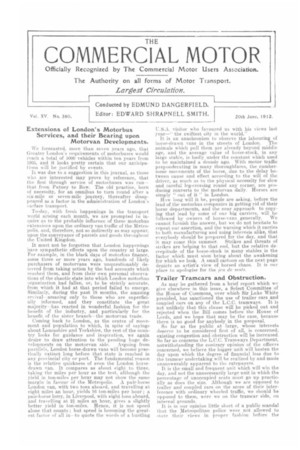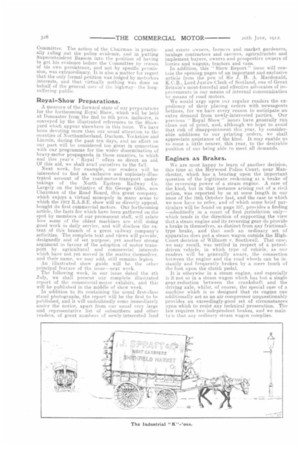Conducted by EDMUND DANGERFIELD. Editor: EDWARD SHRAPNELL SMITH.
Page 1

Page 2

If you've noticed an error in this article please click here to report it so we can fix it.
Extensions of London's Motorbus Services, and their Bearing upon Motorvan Developments.
We forecasted, more than seven years ago, that. Greater London's requirements of motorbuses would reach a total of 5000 vehicles within ten years from 1905, and it looks pretty certain that our anticipations will be justified by events.
It was due to a suggestion in this journal, as those who are interested may prove by reference, that the first through service of motorbuses was run that from Putney to Bow. The old practice, born of necessity, for an omnibus to turn round after a six-mile or seven-mile journey, thereafter disappeared as a factor in the administration of London's surface transport.
To-day, with fresh happenings in the transport world arising each month, we are prompted to inquire as to the probable influence of these motorbus extensions upon the ordinary van traffic of the Metropolis, and, therefore, not so indirectly as may appear, upon the conveyance of parcels and goods throughout the United Kingdom.
It must not be forgotten that London happenings have sympathetic effects upon the country at large. For example, in the black days or motorbus finance, some three or more years ago, hundreds of likely purchasers of motorvans were unquestionably deterred from. taking action by the bad accounts which reached them, a,nd from their own personal observations of the chaotic state into which London motorbus organization had fallen, or, to be strictly accurate, from which it had at that period failed to emerge. Similarly, during the past 18 months, the amazing revival—amazing only to those who are superficially informed, and they constitute the great majority—has reacted in wonderful fashion for the benefit of the industry, and particularly for the benefit of the sister branch—the motorvan trade.
Coming back to London, as the centre of movement and population to which, in spite of sayings about Lancashire and Yorkshire, the rest of the country looks for guidance and inspiration, we again desire to draw attention to the pending huge de velopments on the motorvan side. Arguing from parallels, London horse-drawn vans will become practically extinct long before that state is reached in any provincial city or port. The fundamental reason is the relative quickness of even the London horsedrawn van. It compares as about eight to three, taking the miles per hour as the test, although the yield in ton-miles per hour may not show the same margin in favour of the Metropolis. A pair-horse London van, with two tons aboard, and travelling at eight miles an hour, yields 10 ton-miles per hour ; pair-horse lorry, in Liverpool, with eight tons aboard, and travelling at 2.12 miles an hour, gives a slightly better yield in ton-miles. Hence, it is not speed alone that counts ; but speed is becoming the greatest factor of all in—to quote the words of a hustling C.S.A...visitor who favoured us with his views last year—" the swiftest city in the world." It is an anachronism to observe the labouring of
horse-drawn vans in the streets of London. The animals which pull them are already beyond middle age, and the average value of horse-stock, in any large stable, is badly under the constant which used to be maintained a decade ago. With motor traffic preponderating in many thoroughfares, the cumber some movements of the horse, due to the delay between cause and effect according to the will of the driver, as much as to the physical necessity for slow and careful leg-crossing round any earner, are pi od.ueing converts to the motorvan daily. Horses are simply " out of it " in London.
Hew long will it be, people are asking, before the lead of the motorbus companies in getting rid of their horse departments, and the near approach to copying that lead by some of our big carriers, will be followed by owners of horse-vans generally. We cannot furnish the answer, but we do not hesitate to repeat our assertion, and the warning which it carries to both manufacturing and using interests alike, that everybody should be prepared for the day, and thatit may come this summer. Strikes and threats of strikes are helping to that end, but the relative decrepitude of the horse-stock in many stables is the factor which must soon bring about the awakening for which we look. A small cartoon on the next page depicts an artist's view of horsed chaos. It is our place to apologise for the jai!, de mots.
Trailer Tramcars and Obstruction.
As may be gathered from a brief report which we give elsewhere in this issue, a Select Committee of the House of Commons, over -which Sir Luke 'White presided, has sanctionea the use of trailer cars and coupled ears on any of the L.C.C. tramways. It is not unlikely that this clause will be picked out and rejected when the Bill comes before the House of Lords, and we hope that may be the case, because there is no good for anybody in the proposal.
So far as the public at large, whose interests deserve to be considered first of all, is concerned, existing congestion and obstruction will be increased. So far as concerns the L.C.C. Tramways Department, notwithstanding the contrary opinion of the officers concerned, we believe the bigger unit will hasten the day upon which the degree of financial loss due to the tramcar undertaking will be realized by and made unanswerably apparent to the ratepayers. It is the small and frequent unit which will win the day, and not the unnecessarily large unit in which the percentage of unoccupied seats must go up practically as does the size. Although we are opposed to trailer and coupled cars on the score of their interference with ordinary wheeled traffic, we should be opposed to them, were we on the tramcar side, on internal grounds. It is in our opinion little short of a public scandal that the Metropolitan police were not allowed to state their views in proper fashion before the Committee. The action of the Chairman in practically ruling out the police evidence, and in putting Superintendent Bassom into the position of having to get his evidence before the Committee by reason of his own persistence, and not by specific permission, was extraordinary. It is also a matter for regret that the only formal petition was lodged by motorbus interests, and that virtually nothing was done on behalf of the general user of the highway—the longsuffering public.
Royal-Show Preparations.
A measure of the forward state of our preparations for the forthcoming Royal Show, which will be held at Doncaster from the 2nd to Gth prox. inclusive, is conveyed by the illustrated references to the Showyard which appear elsewhere in this issue. We have been devoting more than our usual attention to the counties of Northumberland, Durham, Yoikshire and Lincoln, during the past ten days, and no effort on our part will be considered too great in connection with our programme for the wider dissemination of heavy-motor propaganda in those counties, to which end this year's " Royal " offers so direct an aid. Of this aid, we shall avail ourselves to the full.
Next week, for example, our readers will be interested to find an exclusive and copiously-illustrated account of the road-motor-transport undertakings of the North Eastern Railway Co. Largely on the initiative of Sir George Gibb, now Chairman of the Road Board, this great company, which enjoys a virtual monopoly in many areas to which the 1912 R.A.S.E. show will so directly appeal, bought its first commercial motors. Our forthcoming article, the facts for which have been gathered on the spot by members of our permanent staff, will relate how some of the oldest machines are still doing good work in daily service, and will disclose the extent of this branch of a great railway company's activities. The complete text and views will provide, designedly and of set purpose, yet another strong argument in favour of the adoption of motor transport by agricultural and commercial interests which have not yet moved in the matter themselves, and their name, we may add, still remains legion. An illustrated show guide will be the other principal feature of the issue—next week.
The following week, in our issue dated the 4th July, we shall present our complete illustrated report of the commercial-motor exhibits, and this will be published in the middle of show week.
In addition to its containing the usual first-class stand photogra.phs, the report will be the first to he published, and it will undoubtedly come immediately under the notice, apart from our usual very large and representative list of subscribers and other readers, of great numbers of newly-interested land and estate owners, fanners and market gardeners, haulage contractors and carriers, agriculturists and implement buyers, owners and prospective owners of lorries and wagons, tractors and vans. In addition, this " Show Report, " issue will contain the opening pages of an important and exclusive article from the pen of Sir J. H. A. Macdonald, K.C.B., Lord Justice-Clerk of Scotland, one of Great Britain's most-forceful and effective advocates of improvements in our means of internal communication by means of road motors. We would urge upon our regular readers the expediency of their placing orders with newsagents betimes, for we have every reason to anticipate an extra demand from newly-interested parties. Our previous " Royal Show " issues have generally run clean out of print, and, although we hope to avoid that risk of disappointment this year, by considerable additions to our printing orders, we shall appreciate assistance of the kind. It may enable us to come a little nearer, this year, to the desirable position of our being able to meet all demands.
Engines as Brakes.
We are most happy to learn of .another decision, this time at the Heywood Police Court, near Manchester, which has a bearing upon the important question of the legitimate reckoning as a brake of the reversing power of a• steam engine. A ease of the kind, but in that instance arising out of a civil action, was reported by us at some length in our issue of the 19th October last, and the ease to which we now have to refer, and of which some brief particulars will be found on page 3:37, provides a finding —admittedly in a court of first jurisdiction only— which tends in the direction of supporting the view that a steam engine and its reversing gear do provide a brake in themselves, as distinct from any frictionaltype brake, and that, such an ordinary set of apparatus does put a steam wagon outside the HighCourt decision of Willmott v. Southwell. That case, we may recall, was settled in respect of a petroldriven vehicle, in which type of vehicle, as our readers will be generally aware, the connection between the engine and the road wheels can be instantly and frequently broken by a mere touch of the foot upon the clutch pedal.
It is otherwise in a steam engine, and especially is it not so in a steam wagon which has but a single gear-reduction between the crankshaft and the driving axle, whilst., of course, the special case of a machine which is so designed that its engine can additionally act as an air compressor unquestionably provides an exceedingly-good set of circumstances upon which to resist any technical prosecution. The law requires two independent brakes, and we main• tan that any ordinary steam wagon complies.
























